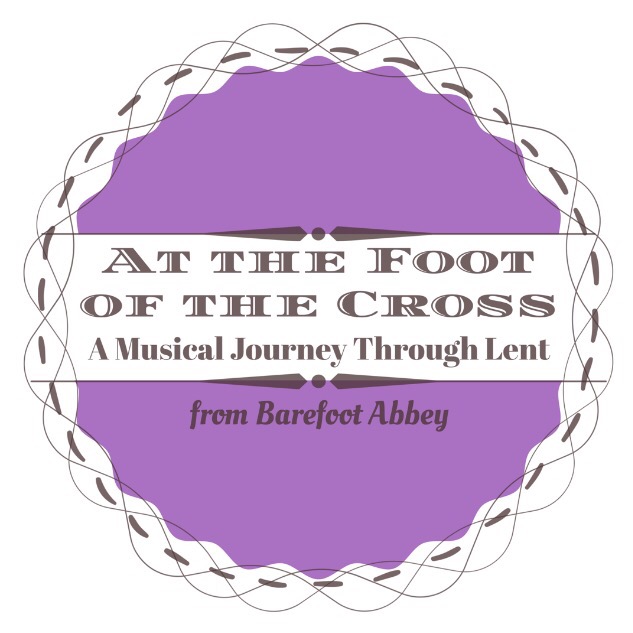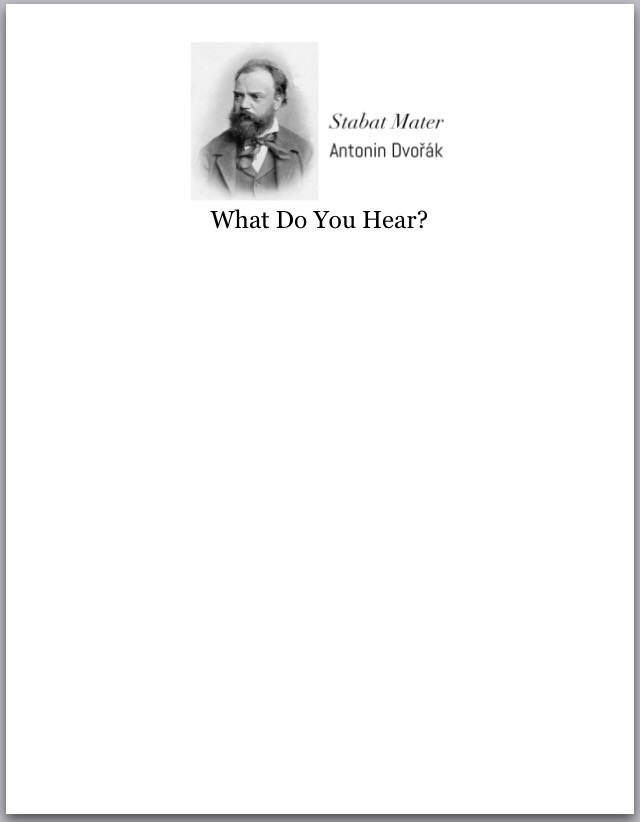
Welcome to Week 1 of our musical journey through Lent, At The Foot Of The Cross! I’m so thankful your family will be joining us!
Each week we will visit a movement or two of Dvořák’s cantata Stabat Mater. YouTube videos of each week’s selection(s) will be provided, along with the sung Latin text from the Medieval hymn its based on and an English translation that may be used as a devotional or for family meditation. Finally at the end of each post. I’ll share a free music appreciation lesson, fit for the whole family, based on one of Dvořák’s ten Stabat Mater movements. This devotion is meant to be very flexible for families of all ages and sizes. Some may only want to read the English translations and listen to the pieces. Others may want to try all the activities below. Do what will work for and help your family grow closer to the Christ is His suffering this season – everything else is straw. If you just found us and would like more background on this Lenten devotion, please visit the Overview post from earlier in the week.
Here are some ways to participate:
- Simply read the Latin text and English translation then listen to the week’s movement(s)
- Have older child(ren) read along with the sung text while listening to the pieces
- Have older child(ren) compare the Latin and English texts
- For older child(ren), use the texts for handwriting or dictation
- Pick one movement’s text tomemorize as a family
- Listen to the full master work during the day as free listening
- Enjoy the weekly music appreciation lesson (at end of this post) as part of your homeschool, morning time, before Lenten devotions, or whenever best suits your family’s schedule
Please let me know in the comments how you plan to participate with your family!
Whole Work Free Listening Playlist
You can find a few ideas for how to incorporate free listening into your day here.
Week 1
Movement 1: “Stabat Mater Dolorosa” – Quartet and Chorus
Latin Text:
Stabat Mater dolorosa
iuxta crucem lacrimosa
dum pendebat Filius.
Cuius animam gementem
contristatam et dolentem
pertransivit gladius.
O quam tristis et afflicta
fuit illa benedicta
Mater unigeniti.
Quae moerebat et dolebat
pia Mater, cum videbat
Nati poenas inclyti.
English Translation:
At the Cross her station keeping,
stood the mournful Mother weeping,
close to her son to the last.
Through her heart, His sorrow sharing,
all His bitter anguish bearing,
now at length the sword has passed.
O how sad and sore distressed
was that Mother, highly blest,
of the sole-begotten One.
Christ above in torment hangs,
she beneath beholds the pangs
of her dying glorious Son.
For our lessons this Lent, we will be using our family’s easy ABC method for listening with purpose. It is a simple three step process that can be used with the whole family and all ages. Usually your family will be listening to the piece three times with a different purpose and activity each time, but this first movement is on the longer side so just listen to as much as possible. The whole lesson typically takes around 15 minutes to complete if you include all three steps. It can be expanded based on length of pieces and the extent of conversation. This method is intentionally adaptable to fit all families in hopes that it will aid in fostering a love of music and meaningful connections in your home. Read through the lesson beforehand, then pull out and use what you know will work with your child(ren).
Our Easy ABCs for Music Appreciation
Begin by gathering everyone together for your listening time and explain how your family will be using this devotion as well as the name of this first movement. Also, at the bottom of this post is a worksheet you may print for each child to participate. (Just click on the picture to download) If you have any questions please don’t hesitate to leave a comment. I want these lessons to be as user friendly as possible!
You can share what you like from the following or use it as an easy script:
Antonin Dvořák’s Stabat Mater is a cantata, a musical work composed for voice and instruments, usually with a choir. The Stabat Mater, “Standing Mother”, Latin text is taken from a 20 stanza Medieval hymn often said to be written by Pope St. Innocent III. The death of his three young children was Dvořák’s inspiration for this composition. As we are all called to do, he turned to the example and comfort of Our Blessed Mother in his time of profound grief. The first movement that we will be listening to is Andante con moto, meaning “moderately slow with movement.” This piece is a quartet of four solo voices in addition to a choir. Written in 1875, it is from the Romantic era of music. The movement begins with a lengthy instrumental introduction similar to those found in the operas of Richard Wagner. It takes the form of AABA, where the title text, “Stabat Mater Dolorosa” returns. It has portions in the expected sad sounding minor keys, but also parts in the happier major keys as well.
A brief biography can be found from Classics for Kids here. I usually include this type of information in the C – Conversation portion of our lesson, but feel free to insert it where you think would work best for your family.
Now onto the main processes of our Listening ABCs.
A – Attentive Listening
Before you play the piece for the first time, ask your family to close their eyes and listen silently. Ask them to try and get a feeling, picture, or story in their mind of what the music reminds them of. They may remember some of the text translation read earlier. For older children, this may be two different answers given the two contrasting segments of major and minor keys. We really want them to get their imaginations running for this first listening. Ask them to share what they saw in the music. There is no right or wrong answer.
B – Bodily Movement
Now we’re going to add a bodily movement to help our brains connect our memory and the music. Here a child can use the printed worksheet to write and or draw what they saw while listening the first time through. It may be more than one thing to make a music collage. If a child recognized specific instruments or elements in the music, they can be included here as well.
C – Conversation
This concluding segment is where we talk about the elements we hear in the music. Each time your family listens with purpose using these ABCs, they will hear and be able to verbalize more and more. Any observation is welcome and should be praised during this listening. Some may hear and mention a specific instrument like the violin, oboe, or bassoon. While others might hear how the instrumental motive (musical idea) in the introduction goes down in pitch. Did anyone notice the key changes? They may say something like, “it sounded happier at one part.” etc…” The mood of the piece can also be discussed here by asking how the music made your family feel and sharing your own response. Again there is no wrong answer to this question.
If not already included previously, you may share the Classics for Kids biography here.
(Just click on the picture to download)


